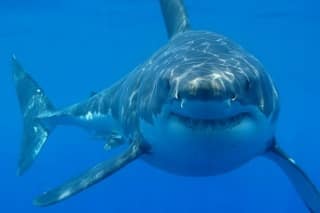Have you ever wondered why the ocean’s apex predator needs to be protected? Are you interested to learn how certain ‘famous’ lady sharks have contributed to bringing awareness to their plight.
Let us introduce you to a couple of ‘leading ladies’ in the world of shark conservation…Nicole and Deep Blue.
Could you imagine migrating from South Africa to Australia via your ‘own steam’?
 Nicole, named after the famous Australian actress (Kidman), is a female great white shark who was tracked from South Africa to Australia and back again. This is a journey of more than 20,000 km in just 9 months. This inter-continental, trans-oceanic migration was the first evidence of the far ranging migration patterns of great whites and was recorded by means of pop-up archival satellite transmitting (“PAT”) tags.
Nicole, named after the famous Australian actress (Kidman), is a female great white shark who was tracked from South Africa to Australia and back again. This is a journey of more than 20,000 km in just 9 months. This inter-continental, trans-oceanic migration was the first evidence of the far ranging migration patterns of great whites and was recorded by means of pop-up archival satellite transmitting (“PAT”) tags.
Nicole was one of the specimens tagged in Haibaai near Dyer Island, Gansbaai, South Africa. Recording the incredible distances covered by great whites was a major revelation and highlighted the need to protect them. It contributed to this species being listed on the CITES Appendix II in October 2004.
Largest great white captured digitally
10 years on and another great white female made the headlines and became a ‘star’ in her own right. Incredible footage was taken by videographer Michael Maier, off Guadalupe Island, Mexico, capturing a female great white. What is amazing about this particular piece of footage (video no longer available) is that it is of a pregnant female, estimated to be 50 years old and a whopping 7m in length! She is known as Deep Blue and has since played a starring role in Discovery Channel’s 2014 Shark Week.
Local researcher, Mauricio Hoyos Padilla, released “Part 2” of the video clip on his Facebook page in August 2015. This additional footage shows the magnificent, gargantuan fish interacting with the divers who are in and on top of the protective cage. “When I first saw Deep Blue, I thought one thing: hope,” Padilla says. “A shark of this size is likely 50 years old, and that tells us that conservation efforts are really working.”
This is great news for cage diving at Guadalupe Island. However, as he explains, “Great whites are protected in the area, but that doesn’t mean these sharks are out of hot water.” Padilla and his team hope to better understand the migration patterns and nursing grounds of these huge animals, so that enforcement can be placed in the most crucial zones.
Dive The World supports shark conservation
We appreciate the importance of protecting the oceans top predators and Dive The World has been supporting Sharklife Conservation Group since 2009. This is just one of the charitable organisations that we support, as do you, every time you book a scuba diving holiday with us.
Have your very own great white experience
Cage diving with great whites is an exhilarating, breathtaking experience. There are 2 awesome locations for you to choose from, Australia and Mexico. Rodney Fox, pioneered white shark cage diving after being a victim of a shark attack. He was passionate about educating the public about these misunderstood titans of the oceans and now owns and operates the Australian Rodney Fox liveaboard Dive The World also recommends a number of Mexican liveaboards that schedule cage diving trips to Guadalupe Island between August and October each year.
Tick this dive off your ‘bucket list’, book your white shark cage diving trip now.
Contact Dive The World right away on +66 (0)94 582 7973 / (0)83 505 7794 or send us an email.